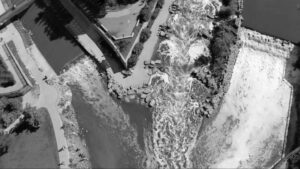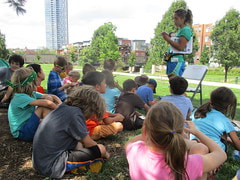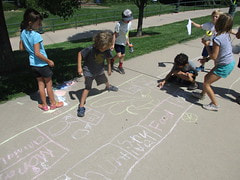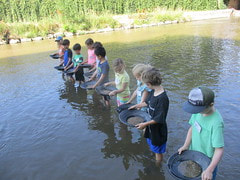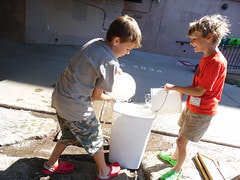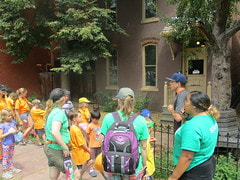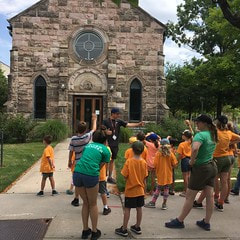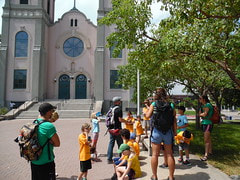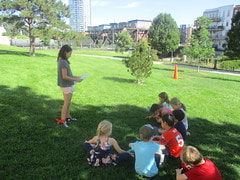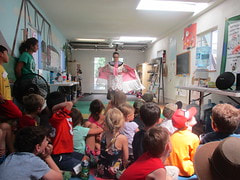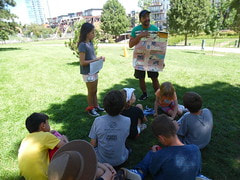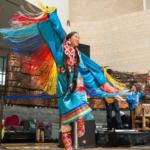SPREE called all budding inventors, architects, and engineers! Campers spent a week designing, building, and inventing while we looked to nature for inspiration.
Monday: Plant Inspiration
We started out our week of camp investigating engineers in nature with plants! Plants are amazing nature engineers from how they grow, how their seeds move, and how they survive. First, we focused on different ways that some native seeds move. There is a wide variety of techniques even in plants we can find around camp! Hitchhiker seeds travel by sticking on to a person or animal, and eventually fall off in a new place. We put socks over our hands and brushed them on the grasses around camp and discovered many seeds sticking to our “fur!” Some seeds we discovered of this variety: burs, goat heads, rabbit brush, wild licorish, and cheat grass. And did you know the invention of velcro was inspired by these types of seeds? Next, we talked about fruit seeds. They get eaten by animals and come out with scat- ready to grow with fertilizer already there! We made “scat” seed balls with dirt, clay, and seeds. Then, we investigated some seeds that travel by wind, like cottonwood and helicopter seeds from box elder trees. We made our own paper helicopters to demonstrate how these seeds move! Another cool way that some seeds move is by water! Wheat grass seeds are shaped like tiny canoes to help them float to new places to grow. We made paper boats as well as craft boats to recreate how these seeds travel!
Finally, we wrapped up our day by planting some seeds of our own to take home to grow!
Monday: Plant Inspiration
We started out our week of camp investigating engineers in nature with plants! Plants are amazing nature engineers from how they grow, how their seeds move, and how they survive. First, we focused on different ways that some native seeds move. There is a wide variety of techniques even in plants we can find around camp! Hitchhiker seeds travel by sticking on to a person or animal, and eventually fall off in a new place. We put socks over our hands and brushed them on the grasses around camp and discovered many seeds sticking to our “fur!” Some seeds we discovered of this variety: burs, goat heads, rabbit brush, wild licorish, and cheat grass. And did you know the invention of velcro was inspired by these types of seeds? Next, we talked about fruit seeds. They get eaten by animals and come out with scat- ready to grow with fertilizer already there! We made “scat” seed balls with dirt, clay, and seeds. Then, we investigated some seeds that travel by wind, like cottonwood and helicopter seeds from box elder trees. We made our own paper helicopters to demonstrate how these seeds move! Another cool way that some seeds move is by water! Wheat grass seeds are shaped like tiny canoes to help them float to new places to grow. We made paper boats as well as craft boats to recreate how these seeds travel!
Finally, we wrapped up our day by planting some seeds of our own to take home to grow!
Tuesday: Heading West
After the mountain explorers arrived, eventually more and more explorers, prospectors, and pioneers started heading west and stopping in Colorado. Many were looking for land, gold, and a new life! But traveling in the 1800s wasn’t easy! Campers reenacted the journey to Colorado by packing up mini wagons with supplies, acting out some dangers along the way (like fording a river or trying to repair a broken wagon wheel), and needing to find food and water along the way. Next, we investigated the first chartered town in what is now Colorado- Montana City! Montana city was built in 1858 along the South Platte near where Grant Frontier park sits today. The residents settled here to look for gold in the river, but quickly realized there was not as much around as they had expected. The residents actually decided to disband and relocate 9 miles downstream (near modern- day confluence park) as part of another existing town, while bringing their homes with them! Campers brainstormed how they accomplished this, then acted out what they did- floating the logs of their homes down the river, and rebuilding with them at the new site! Next, campers reenacted the flood of the Cherry Creek in 1864. The little towns at the confluence were hit hard, but decided to rebuild! Thanks to these resilient settlers, little Denver City eventually grew into the modern Denver that we know today!
After the mountain explorers arrived, eventually more and more explorers, prospectors, and pioneers started heading west and stopping in Colorado. Many were looking for land, gold, and a new life! But traveling in the 1800s wasn’t easy! Campers reenacted the journey to Colorado by packing up mini wagons with supplies, acting out some dangers along the way (like fording a river or trying to repair a broken wagon wheel), and needing to find food and water along the way. Next, we investigated the first chartered town in what is now Colorado- Montana City! Montana city was built in 1858 along the South Platte near where Grant Frontier park sits today. The residents settled here to look for gold in the river, but quickly realized there was not as much around as they had expected. The residents actually decided to disband and relocate 9 miles downstream (near modern- day confluence park) as part of another existing town, while bringing their homes with them! Campers brainstormed how they accomplished this, then acted out what they did- floating the logs of their homes down the river, and rebuilding with them at the new site! Next, campers reenacted the flood of the Cherry Creek in 1864. The little towns at the confluence were hit hard, but decided to rebuild! Thanks to these resilient settlers, little Denver City eventually grew into the modern Denver that we know today!
Wednesday: Pioneer Life
As we continued to learn about the lives of Colorado pioneers and prospectors, today, campers focused on how they lived day to day. We acted out the gold rush through a game, and discovered that despite the optimistic reports, there was actually not much gold to find in Colorado waterways. Next, we acted out some pioneer chores and skills! Campers learned the basics of washing laundry in the creek, made some tin art, gathered water with buckets, and even practiced some cattle roping! Campers also got to get into the water to actually practice gold panning just like the early prospectors did!
As we continued to learn about the lives of Colorado pioneers and prospectors, today, campers focused on how they lived day to day. We acted out the gold rush through a game, and discovered that despite the optimistic reports, there was actually not much gold to find in Colorado waterways. Next, we acted out some pioneer chores and skills! Campers learned the basics of washing laundry in the creek, made some tin art, gathered water with buckets, and even practiced some cattle roping! Campers also got to get into the water to actually practice gold panning just like the early prospectors did!
Thursday: Field Trip
We had a special field trip this week at nearby Auraria campus. We packed up, walked along the river trail, and met our tour guides at the historic Auraria campus. History Colorado Center tour guides walked us through some of the amazing history that took place in that spot. Campers learned about the early Colorado towns that were settled there in the mid-1800s, explored some of the turn of the century buildings that are still standing, and learned how Auraria has transformed over the last century and a half. There was a lot of walking that day, but campers still had fun and learned a lot!
We had a special field trip this week at nearby Auraria campus. We packed up, walked along the river trail, and met our tour guides at the historic Auraria campus. History Colorado Center tour guides walked us through some of the amazing history that took place in that spot. Campers learned about the early Colorado towns that were settled there in the mid-1800s, explored some of the turn of the century buildings that are still standing, and learned how Auraria has transformed over the last century and a half. There was a lot of walking that day, but campers still had fun and learned a lot!
Friday: Gold Mining and Special Guest!
Once the initial gold rush died down a bit and prospectors realized that there was not much gold to be found in Colorado’s waterways, they decided to look for it right at the source- in the mountains! On Friday, campers learned about the early Coloradan gold miners. First, we played a game to act out some of the dangers that miners faced. They did get some gold out of the mines, but not before facing dangers like gas leaks, floods, collapsing tunnels, and unreliable DIY dynamite! Next, we learned about the tricky process of getting the gold out of the mined rocks. It wasn’t as easy as finding a nugget in the riverbed! Then, we made our own gold holding pouches to take home some treasures of our own in!
As part of our history week, one of our SPREE staff along with her mom presented as special guests! Lily of the Kainai Blood Tribe in Alberta, Canada presented with her mom, Khena, to teach the campers about some native peoples and traditions. Campers had a great time trying out some traditional dances, seeing traditional clothing, and learning about different cultures than their own. Lily also wrote a piece to add to our blog, seen below.
Finally, we wrapped up our Colorado Frontier week with a graduation ceremony to celebrate all of the campers becoming history experts over the week!
Once the initial gold rush died down a bit and prospectors realized that there was not much gold to be found in Colorado’s waterways, they decided to look for it right at the source- in the mountains! On Friday, campers learned about the early Coloradan gold miners. First, we played a game to act out some of the dangers that miners faced. They did get some gold out of the mines, but not before facing dangers like gas leaks, floods, collapsing tunnels, and unreliable DIY dynamite! Next, we learned about the tricky process of getting the gold out of the mined rocks. It wasn’t as easy as finding a nugget in the riverbed! Then, we made our own gold holding pouches to take home some treasures of our own in!
As part of our history week, one of our SPREE staff along with her mom presented as special guests! Lily of the Kainai Blood Tribe in Alberta, Canada presented with her mom, Khena, to teach the campers about some native peoples and traditions. Campers had a great time trying out some traditional dances, seeing traditional clothing, and learning about different cultures than their own. Lily also wrote a piece to add to our blog, seen below.
Finally, we wrapped up our Colorado Frontier week with a graduation ceremony to celebrate all of the campers becoming history experts over the week!
Special Guest Spotlight! (Blog by Lily Rankova, College Ranger)
A pow-wow is a social gathering held by many different Native American communities. A modern pow-wow is a specific type of event for Native American people to meet and dance, sing, socialize, and honor their cultures. Pow-wows are to celebrate and bring together friendship, whether it be from other tribes or from people of different backgrounds.
There are many different types of dances, each with its own special story. These dances do come from different tribes, but can be adopted by members of other tribes.
Women’s fancy shawl, a dance both my mother and I practice, didn’t take off until the 1950’s. Women in northern tribes incorporated traditionally feminine aspects, fancy shawl is often said to resemble butterflies.
A pow-wow is a social gathering held by many different Native American communities. A modern pow-wow is a specific type of event for Native American people to meet and dance, sing, socialize, and honor their cultures. Pow-wows are to celebrate and bring together friendship, whether it be from other tribes or from people of different backgrounds.
There are many different types of dances, each with its own special story. These dances do come from different tribes, but can be adopted by members of other tribes.
Women’s fancy shawl, a dance both my mother and I practice, didn’t take off until the 1950’s. Women in northern tribes incorporated traditionally feminine aspects, fancy shawl is often said to resemble butterflies.
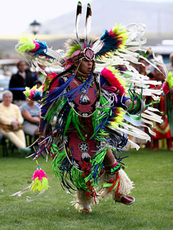
There is also a men’s fancy, which is attributed to two young Ponca boys who created a fast moving, audience pleasing routine in 1928. This dance was first found at the Ponca tribe’s dance arena in White Eagle, Oklahoma.
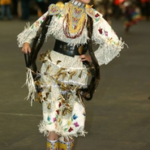
Women’s jingle dance is attributed to three different Ojibwa tribes. The dress and the dance first appeared in a recurring vivid dream. In the dream, there were four women, each wearing a jingle dress and dancing. The dream gave instructions on how to make the dress, what type of songs went with the dance, and how the dance was performed. The dance represents healing, so if there is someone who is sick, it is requested that women jingle dance for that sick person.
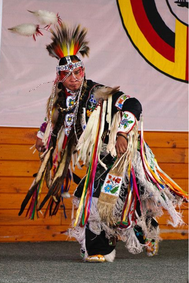
There are many different stories for men’s grass dancing, but the most commonly known is that scouts of tribes would bless the land by flattening the grass for a ceremony, dance, or battle.
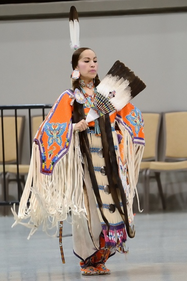
Women who dance traditional are looked on with reverence as the elegant presence at a pow-wow. Traditional is a dance that exemplifies dignity, grace, and modesty. Women’s traditional is one of the oldest dances you can see at a pow-wow.
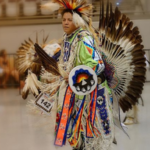
Men’s traditional dance is also one of the oldest dances you can see at a pow-wow. Often “animal” in nature, meaning the dance honors the different animals the Creator has put on Earth. This dance represents movements of the hunter and gatherer.

